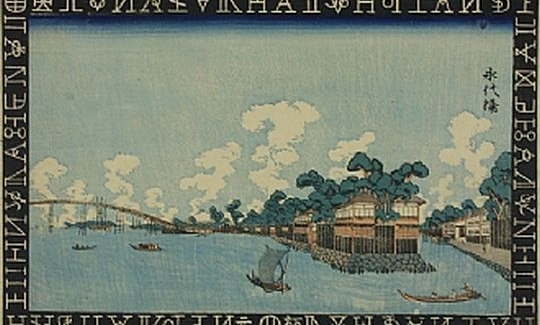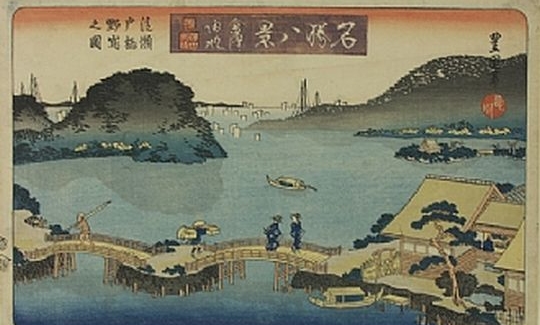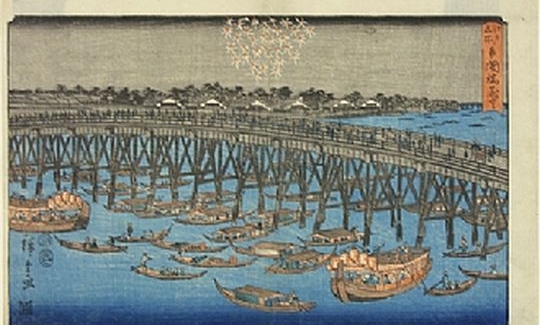In traditional Japanese art bridges are depicted in paintings and prints of landscapes and scenery, but there is no specific "bridge" genre. The coloured woodblock prints present bridges which no longer exist, or which have been replaced. They also show wooden bridges which are still standing, such as the famous Kintai Bridge, built in 1673 in Iwakuni (which is today the Province of Yamaguchi), and the Saruhashi, the Monkey Bridge suspended over a deep, narrow gorge in Otsuki (Yamanashi Province).
According to Japanese mythology, the bridge connects the world of the gods with that of mankind. It is related that when the deities Izanagi and Izanami crossed the floating bridge of heaven, Izanagi dipped his sacred lance in the waters of the ocean, and the drops falling from it formed the Japanese islands. Even today the bridge that connects the stage of the Noh Theatre with the actors' dressing-rooms symbolizes the passage from the world of the gods and the spirits of the dead to the world of the living.
The ethnological dictionary of Japanese folklore (Minzokugaku-jiten) tells us that in earlier times the craft of bridge-building was not simple. The Ohashi (great) bridges were not really large, but small and short, and very few were constructed over the raging torrents of the great rivers. In many works of art, the bridges look larger and more imposing than they really were, because the artists preferred to depict them thus.
The stormy Japanese climate - the monsoons, heavy rains, and typhoons - made it very difficult to maintain these bridges in good order. The force of the river currents increased during these seasons, and many bridges were easily destroyed. Japanese legends relate that in the early days it was customary to sacrifice a man (Hitobashira: a human pillar) during the building of bridges, canals, or castles, to appease the spirits of the storm gods. This guaranteed that the structures would be sturdier and stronger. The first reference to human sacrifice appears in the "Nihon Shoki" chronicle (720 CE), in the chapter about the reign of the Emperor Nintoku. A story of a peasant who sacrificed himself for the Nagara Bridge in Tsurumi (now Hyogo Province) is particularly well-known. Many of the victims were women, who became goddesses after death. Tales of human sacrifice were mainly disseminated by the Miko (female shamans), who conducted rituals to pacify the water gods (Suijin).
The earliest records of Japan relate that the first bridge in the country was built in the 4th century CE in Ikai no Tsu - which is today Osaka. But the techniques of the lovely and renowned Chinese wooden bridges reached Japan via Korea only in 612 CE. Frequently, when a bridge was constructed, a special place was left at the base of one of its supports for one of the fertility goddesses of the Shinto religion. In the mythology, this goddess had a tempestuous love-life, so the Japanese prayed to her for easy childbirth and successful rearing of children. According to another belief, ghosts and demons may be hiding underneath bridges.
After the Meiji Restoration of 1868, European bridge-building techniques were brought to Japan. The first steel bridge was built in Nagasaki in 1869. In the earthquake of 1923 in Tokyo, many bridges were destroyed, and were replaced by new ones, including the Eitai Bridge.
Even today, when a bridge is completed, the Japanese conduct a ceremony in which three generations of the same family cross the bridge so that it will endure for generations to come.
The prints and drawings in the exhibition teach us about the unique architectural structure of the lovely wooden and stone bridges which have so influenced the impressionist painters of Europe, including Vincent van Gogh and Claude Monet.




